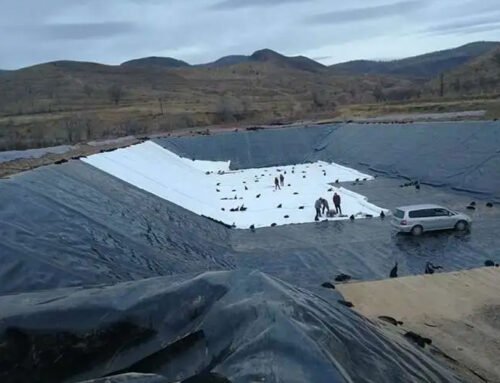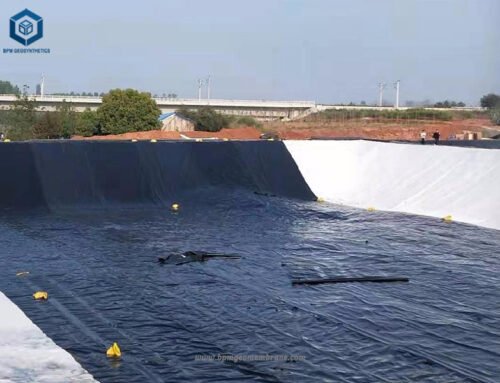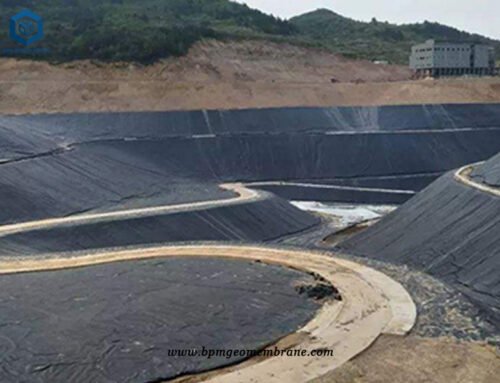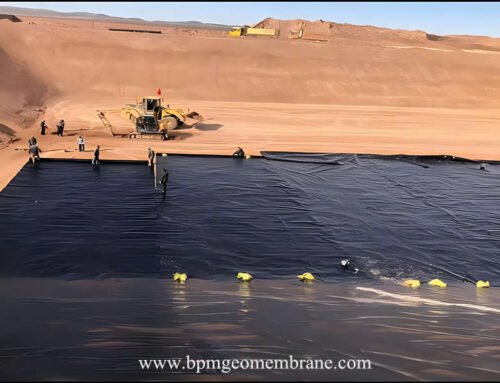Polyethylene pond liner features high tensile strength, stable chemical properties, tear and puncture resistance, UV stabilization and flexibility for deployment for a wide and growing range of applications including landfills, lagoons, channels and fish farming ponds, in addition to other engineering works.
Polyethylene pond liner, used for decades in waste containment. Durability, seepage proofing, and price make it a standard product in some areas. Some view it as basic construction material. However, it’s the sole barrier between soil and contaminants, making it a crucial environmental product.
What are the characteristics of polyethylene pond liner?
Polyethylene pond liner is a popular material used in the construction of ponds, water features, and other liquid containment systems. Its characteristics make it an ideal choice for these applications. Here are some of the key characteristics of polyethylene pond liner:
Durability:
Polyethylene is known for its strength and resilience. It can withstand harsh weather conditions, including extreme temperatures and UV radiation, without degrading or becoming brittle over time. This ensures a long lifespan for the pond liner.
Flexibility:
Despite its durability, polyethylene is also highly flexible, allowing it to conform to the shape of the pond or water feature. This flexibility makes installation easier and ensures a snug fit, reducing the risk of leaks.
Resistance to Chemicals:
Polyethylene is resistant to a wide range of chemicals, including acids, bases, and salts. This makes it suitable for use in various environments, including those with high levels of salinity or acidity.
Environmental Friendliness:
Polyethylene is a non-toxic material, making it safe for use in ponds and other bodies of water. It does not leach harmful substances into the water, ensuring that the water remains clean and safe for aquatic life.
Cost-Effectiveness:
Compared to other materials used for pond liners, such as PVC or rubber, polyethylene is generally more affordable. This makes it a cost-effective solution for both residential and commercial pond projects.
Ease of Installation:
Polyethylene pond liner is lightweight and easy to handle, which simplifies the installation process. It can be cut to size and shaped to fit the contours of the pond, and it can be secured using weights, rocks, or other anchoring methods.


What are the applications of Polyethylene Pond Liner?
Polyethylene pond liner has a wide range of applications due to its durability, flexibility, and resistance to chemicals and weather conditions. Here are some of the primary uses:
Aquaculture:
Polyethylene liners effectively contain water in aquaculture systems while preventing soil contamination. They create stable environments that support healthy fish growth throughout production cycles. These durable liners resist punctures from aquatic species and equipment during operation. Farmers appreciate how easily they install compared to concrete alternatives. The material’s flexibility accommodates various pond shapes and sizes efficiently.
Water Storage:
Polyethylene liners reliably prevent water seepage in storage ponds while maintaining water quality. They effectively block contaminants from entering the water supply through soil contact. Installers quickly deploy these liners across various reservoir shapes and sizes. The material withstands prolonged exposure to sunlight without degrading significantly. Operators consistently choose these liners for their proven long-term performance in water containment.
Landfill Liners:
Engineers commonly install polyethylene liners as primary containment systems in landfills. These durable membranes effectively block leachate migration into surrounding soils. The impermeable material prevents harmful chemicals from reaching groundwater sources. Landfill operators rely on them for long-term environmental protection. Proper installation ensures complete isolation of waste from the ecosystem.
Construction of Water Features:
Landscape designers frequently choose polyethylene liners for water features because they provide reliable containment. These versatile materials easily form the base of decorative ponds while maintaining clean water clarity. The smooth surface enhances visual appeal and complements surrounding garden elements. Installers appreciate how the flexible material adapts to creative shapes and contours. Homeowners enjoy durable, low-maintenance water features that last for years.
Environmental Protection:
Environmental engineers increasingly utilize polyethylene liners for wetland restoration projects due to their effectiveness. These durable barriers create stable foundations for artificial wetland ecosystems while preventing water loss. Shoreline stabilization projects commonly incorporate them to combat erosion from waves and currents. The material’s flexibility allows seamless adaptation to various terrain contours. Conservationists value these liners for providing long-term protection to vulnerable aquatic habitats.
Agricultural Applications:
Farmers regularly install polyethylene pond liners to create efficient irrigation systems that conserve water. These durable liners effectively store agricultural runoff while preventing chemical seepage into groundwater. The material reliably contains liquid fertilizers and pesticides within designated treatment areas. Agricultural operations benefit from their resistance to punctures and UV degradation. Many producers choose these liners for their cost-effectiveness and long service life.
Recreational Facilities:
Construction teams frequently select polyethylene liners for recreational water projects due to their durability. These versatile materials create smooth, non-abrasive surfaces ideal for swimming pools and splash pads. The waterproof barrier prevents leaks while maintaining consistent water levels throughout seasons. Safety inspectors approve them for their slip-resistant properties in wet environments. Property owners appreciate how these liners require minimal maintenance while lasting decades.
Wastewater Treatment:
Engineers commonly install polyethylene liners in wastewater treatment facilities to create secure containment systems. These specialized membranes effectively prevent leaks from treatment lagoons while maintaining process integrity. Operators rely on them to isolate bioreactors from surrounding soil and groundwater completely. The chemical-resistant material withstands constant exposure to harsh treatment chemicals reliably. Municipalities consistently choose these liners for their proven performance in critical water infrastructure projects.
Mining Operations:
Mining operations routinely install polyethylene liners to safely contain tailings and process slurry. These robust barriers effectively prevent toxic materials from contaminating surrounding ecosystems. Engineers design them to meet strict environmental regulations while withstanding harsh mining conditions. The liners reliably isolate hazardous byproducts from groundwater sources for decades. Many mining companies now consider them essential for sustainable, compliant waste management practices.
Secondary Containment:
Secondary containment systems are crucial in industrial environments. They act as a backup to primary containment measures. Their main purpose is to prevent spills and leaks from spreading.
Case Study Of Polyethylene Pond Liner
Our Thailand customer reached out via www.bpmgeomembrane.com. He visited our factory and a biogas pool project site. Engineers recommended 1.2mm and 1.5mm GM-13 HDPE Geomembranes. The marsh gas pool cover will use the 1.2mm pond liner. The ground floor will have a 1.5mm pond liner. Customer was pleased with our detailed proposal. He placed the order and paid the deposit.
Polyethylene Pond Liner for Biogas Pool Project Specifications
- Total 1.2mm and 1.5mm geomembrane quantity – 21700m2
- Geomembrane specification – 7m*100m/roll
- One 40GP container


As the leading geomembrane manufacturer in China, BPM had been dedicated in providing one stop geomembranes and geosynthetics to worldwide customers for over 10 years. BPM is also providing professional design and installation service. OEM and ODM are also available. If you have any questions or inquiries, please fill and submit the following form, we will reply as soon as possible.
Summarize
The utilization of polyethylene pond liner in the biogas pool project in Thailand signifies a pivotal step towards sustainable energy solutions and environmental conservation. By employing this durable, impermeable material, the project ensures minimal leakage and contamination, thereby safeguarding both groundwater quality and the integrity of the biogas production process. Furthermore, polyethylene’s longevity and resistance to harsh environmental conditions make it an ideal choice for such projects, promising long-term efficiency and reducing maintenance costs. This initiative not only contributes to Thailand’s renewable energy goals but also sets a precedent for eco-friendly waste management practices, demonstrating how innovative materials can play a crucial role in addressing contemporary energy and environmental challenges.





